Brazilian Commandos
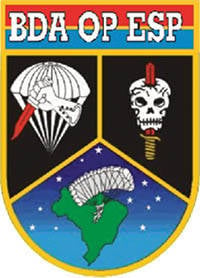 The new development scenario of the world threatens the growth of Islamic terrorism of a fundamentalist sense, as well as the strengthening of the drug war, in particular, with the militants of the FARC group in Colombia. The current situation requires the Brazilian armed forces to be highly prepared to carry out combat missions and conduct humanitarian operations in cooperation with UN agencies. Under these conditions, the Brazilian government decided to establish a special operations brigade in the structure of the armed forces (Bda Op Esp).
The new development scenario of the world threatens the growth of Islamic terrorism of a fundamentalist sense, as well as the strengthening of the drug war, in particular, with the militants of the FARC group in Colombia. The current situation requires the Brazilian armed forces to be highly prepared to carry out combat missions and conduct humanitarian operations in cooperation with UN agencies. Under these conditions, the Brazilian government decided to establish a special operations brigade in the structure of the armed forces (Bda Op Esp).Today we publish the memories of the participants of those events, the commander and fighters of the 2th paratrooper platoon (Carmin 2) of the 8th parachute regiment of the French marines (8 e RPIMa). There are no tactics, no figures, no ratings. The paratroopers confirm - in that battle, they really did everything they could. And as professionals, with dignity coming out of the deadly whirlwind of lead and steel, and as people — without abandoning those who could still be helped.
History Brazilian Special Forces begins with 1953, when a rescue unit was created from officers and sergeant paratroopers. All of them were trained in special groups and companies of the Rangers of the American army, after which they themselves began to train special operations soldiers in the Brazilian army. The first course ended in 1957 year.
Created in the 1960-x and 1970-ies of the last century, special forces have gained extensive experience in counter-partisan operations in Brazil. Brazilian experts even developed their own doctrine of fighting insurgents and partisans in rural areas.
The first subdivision of the modern special operations brigade was the 1 th special-purpose battalion, which was created by 1 in November 1983. Its creation was attended by commando units and special forces units of the Brazilian army. From 27 September 1984, the battalion occupied the Camboat barracks in Rio de Janeiro. In November 1991, the battalion was given the honorary name of Antonio Diaz Cardoso, who is considered the progenitor of the Brazilian special forces.
Special Operations Brigade
Creation of a brigade
At present, the special operations team (Bda Op Esp) of the Brazilian army is the most versatile and effective unit capable of ensuring a quick response to emerging crises and conflicts.
The formation of the brigade began in January 2004, when the command of the ground forces issued an order to organize the core of the brigade. Most of her subordinate units were located in the Camboat barracks in the west of Rio de Janeiro, where the Specialized 1 Battalion had been previously formed.
At that time, the brigade consisted of 2000 soldiers who could be deployed to any part of the country during 6 hours. The location of the brigade was a military complex in the region of Santa Zhenovieva, in Goiânia.
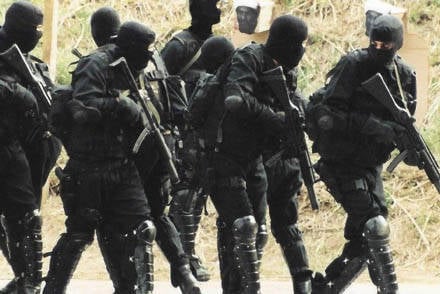 Initially, a special operations brigade was to be stationed in Rio de Janeiro, but given the strategic location of the Central Highland, the command of the ground forces decided to deploy a new compound in Goiânia. In addition to 500, special purpose battalion of the 1 Special Forces battalion in Goiania during the formation of the brigade sent 45 troops to the platoon of radiation, biological and chemical protection. In addition, a commando battalion, a squad of psychological operations, an operational support squad and a police platoon were formed in Rio.
Initially, a special operations brigade was to be stationed in Rio de Janeiro, but given the strategic location of the Central Highland, the command of the ground forces decided to deploy a new compound in Goiânia. In addition to 500, special purpose battalion of the 1 Special Forces battalion in Goiania during the formation of the brigade sent 45 troops to the platoon of radiation, biological and chemical protection. In addition, a commando battalion, a squad of psychological operations, an operational support squad and a police platoon were formed in Rio.The special operations team is directly subordinate to the military command of the plateau, located in the city of Brasilia, and the command of ground operations of the federal district is responsible for its preparation and use. All brigade special forces units are part of the strategic rapid-reaction forces and interact with all military units of the Brazilian army.
Location convenience
Goiânia is the geographical center of the country. At a distance of a thousand miles around, 116 lives of millions of people, or 62% of the Brazilian population. No other city in the country is as strategic as Goiania, the capital of the state of Goiás. In addition, in the immediate vicinity of the brigade are the air base in Annapolis and the airport of Santa Zhenovieva. Everything else Goiania is located just 200 kilometers from the capital of the republic.
In this garrison, the 42 and 43 battalions of the motorized infantry, as well as the 3 motorized infantry brigade, were previously located. After them, a rather powerful infrastructure remained in Goiânia, including even a special pool for training combat swimmers.
Tasks and application
The brigade can be effectively used in order to significantly weaken the enemy’s military potential by direct or indirect action against its rear infrastructure, command and control system and aerospace defense. Among the extensive list of tasks facing the connection, we can distinguish the main ones:
- deployment in the enemy's rear;
- collection of information on the battlefield;
- implementation of the search, destruction, neutralization and suppression of the actions of an object of significant importance;
- guidance aviation on target for air strikes;
- conducting rescue operations;
- language capture;
- planning and conducting guerrilla war operations:
- subversive activities in the rear of the enemy;
- organization and conduct of sabotage;
- organization and leadership of the resistance movement (guerrilla), directed against the large occupying forces in cooperation with the regular troops of the Brazilian armed forces;
- The fight against the rebels;
- carrying out counter-terrorist operations, including the release of hostages held in an airplane, bank, subway or on board a ship;
- ensuring the safety of VIPs and strategic facilities; assault on terrorist bases; decontamination of explosive devices; monitoring of terrorist groups.
The Brazilian Special Operations Brigade fighters developed their own application doctrine, which, despite some characteristic features, is very similar to the tactics of other well-known special forces such as Delta Force and SAS.
The use of brigade forces is extremely flexible and relies on a wide range of organizational procedures and a variety of methods for using available resources. The team is able to conduct deep operations with minimal support. However, it can solve both tactical and strategic tasks, acting in the immediate response mode.
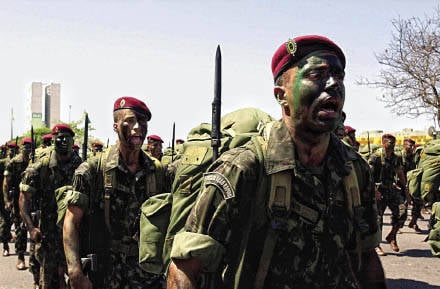 Commando shares are characterized by surprise and aggressiveness. Actions in adverse areas, usually under the control of the enemy, require accuracy of planning and application. The personnel of the CO brigade can destroy airfields, radar, anti-aircraft batteries, port facilities, dams and dams, bridges and roads, facilities, as well as command and control bodies.
Commando shares are characterized by surprise and aggressiveness. Actions in adverse areas, usually under the control of the enemy, require accuracy of planning and application. The personnel of the CO brigade can destroy airfields, radar, anti-aircraft batteries, port facilities, dams and dams, bridges and roads, facilities, as well as command and control bodies.The brigade is the main combination of quick reaction forces, which are supplemented by the following formations: infantry parachute brigade, 12th light infantry brigade (airmobile) and army aviation squadron. Rapid reaction forces are capable of operating in the south in the ammunition of the Amazon. In addition, they are trained to perform chemical defense tasks, as a rule, in countering terrorist groups. The special forces brigade conducts joint operations with other army units, fleetas well as with the air force.
Manning
In the brigade serve only volunteers. Candidates for service in the brigade are primarily selected according to their physical data. Then proceed to the preparation, in which the psychological component is very important. A volunteer must have a variety of skills: mastering skydiving, light swimming, training of various kinds weaponsand also learn how to work on radio stations of various types.
The personnel of the brigade also fulfills the release of hostages when terrorists seize aircraft.
From the very beginning, in Rio de Janeiro, the compound was staffed by highly qualified officers, and the personnel were already recruited in Goiânia from military units stationed in various regions of the country.
Training a personal team of special operations brigade costs the treasury more than training soldiers of other units of the Brazilian armed forces and lasts at least three years. When selecting candidates from 3000, there are no more than 300 that are added to the connection state.
Armament and equipment of the brigade
The specific requirements of special operations determine the special type of weapons and equipment used. The brigade has its own vehicles. Army helicopters, air force planes, or navy ships are used to move.
The team has at its disposal the most modern equipment, including laptop computers, night vision devices, equipment for special operations in the jungle, mountains and savanna. The armament has a wide variety of weapons, communications equipment, laser-guided rifles, diving and mining equipment. When conducting operations to free hostages, fighters, as a rule, use HK MP5 submachine guns equipped with silencers.
Brigade structure
The JI brigade headquarters coordinates and controls the activities of the brigade units. It consists of: Special purpose battalion 1, commando action battalion 1, psychological operations squad, special operations support squad, brigade administrative base, 1 defense platoon against chemical, biological and nuclear weapons, military 6 squad police and training center for special operations.
Special purpose battalion 1
The 1 Specialty Battalion (1 Batalhão de Forças Especiais - 1 BF Esp), which is currently based in the city of Goiania, was established in 1983 in the garrison of Rio de Janeiro.
The missions of the battalion consist in organizing, developing, equipping, training, and directing paramilitary forces during operations involving guerrilla groups, sabotage, sabotage, evading captivity, and escaping. In addition, the personnel are well prepared for counter-terrorist and counter-partisan operations. In the conduct of non-traditional warfare, a wide range of both military and paramilitary operations conducted on the territory of the enemy or controlled by him is used. These operations are carried out in the interests of the main strategic command or command and command-line operational level.
The special purpose battalion 1 can be used both in peacetime and during a crisis or armed conflict. The goal of operations is to achieve political, economic, military or psychosocial goals set by management.
Structure and capabilities
The battalion organizationally consists of the command and headquarters, two companies of special forces (Companhias de Forças Especiais), which form the operational detachments of special forces (Destacamentos Operacion de Forças Especiais - DOFEsp). Also in the battalion is a detachment to combat terrorism (Destacamento Contraterrorismo) and a company of command and support (Companhia de Comando e Apoio).
Operational detachments and battalion teams in the area of operation are capable of:
- carry out subversive work against land, sea-based objects or against air force objects;
- to conduct psychological operations of a limited nature, primarily in their own interests;
- in the deployment areas to provide support for troops to conduct ground air and airborne operations, the landing of naval assault and air strategic operations;
- to carry out special operations of direct impact of a limited nature;
- on the strategic, operational or tactical direction by the commando forces to carry out actions to prohibit, eliminate, destroy, eliminate or capture enemy personnel or materials of interest to their command;
- for a long period of time with minimal support and guidance from the outside to act in the territory occupied or controlled by the enemy;
- perform other combat and reconnaissance operations.
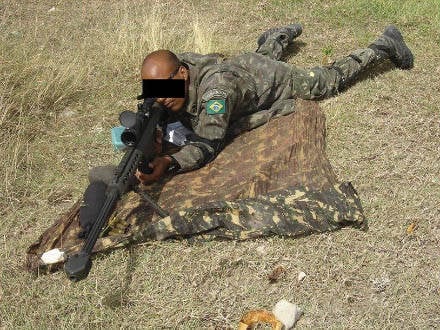 The 1 Battalion can also assist other units of the armed forces in the case of the use of commando operations or special forces of the enemy against them.
The 1 Battalion can also assist other units of the armed forces in the case of the use of commando operations or special forces of the enemy against them.Special Forces Detachments
But the main operational element of the Brazilian special operations forces are the special operations units (Destacamento Operacional de Forças Especiais).
They consist of four officers that make up the headquarters, and four pairs in which there is a sergeant and a corporal. All members of the squad are highly qualified scouts. In the field, they can observe, identify objects, and also collect and send to the headquarters analytical information about the enemy, based on indirect information. The detachment is self-sufficient and includes specialists in communications, mine-disruptive business, weapons and medicine.
However, the task of special forces are not limited only to the conduct of observation. Fighters are able to form and organize the actions of irregular units in the deep rear of the enemy. To accomplish this task, fighters of the detachments are trained in the organization and conduct of psychological operations.
Anti-terrorism unit
The special operations team is the only formation of the Brazilian army, which has in its composition a unit for combating terrorism. The anti-terrorism unit (Destacamento Contraterrorismo - DCT) consists almost exclusively of officers and sergeants who have completed special forces training.
Currently, with the growth of the terrorist threat, the command is paying more and more attention to the training of brigade personnel to suppress and prevent insurgent actions. These tasks are also assigned to the anti-terrorism unit.
Counterterrorism operations require special speed and clarity in the implementation of all their elements. This is ensured by the high level of training of all the fighters of the teams who have the skills of high-precision shooting from different types of weapons, confident actions when descending from the steep walls on the ropes. The unit is ready to conduct operations at various levels of complexity, both for the release of hostages and the liquidation of terrorist groups. In preparation, a phased entrance to the building is being worked out. During the class used live ammunition.
Intensive and complex training provided highly qualified units and its personnel. Their confident shooting skills guarantee the safety of civilians during hostage-release operations.
The anti-terrorism unit has modern tactical training in confined spaces. To do this, use a set of ammunition, weapons and uniforms that mimic regular samples. So, for example, 9-mm cartridges with paint of different colors make it possible to reveal a hit, which is fixed on a special form. It consists of a helmet, vest, shirt and trousers. All this is made from a special material that improves the fixation of hits.
The weapons used are 9 mm M4 carbines, MP5 submachine guns and Glock pistols, which have modifications that allow the use of special ammunition.
1 Battalion Action Commando
The 1 Battalion Commandos Action Battalion (1 Batalhão de Ações de Comandos - 1 BAC) consists of a command and headquarters, a company of command and support (Cia C Ap), a reconnaissance unit of hunters (Destacamento de Reconhecimento e Caçadores - DRC) and three companies in the company of three companies, (CiaAçCmdos). Each company consists of three squads of commando shares (Destacamentos de Ações de Comandos - DAC).
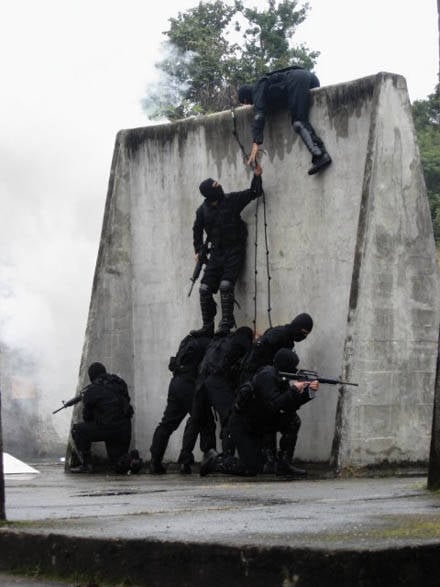 The task of this unit is to act in the rear of the enemy. The 1 Battalion Commando Action Battalion is designed to plan, conduct, and perform special operations. He has a high tactical and strategic mobility.
The task of this unit is to act in the rear of the enemy. The 1 Battalion Commando Action Battalion is designed to plan, conduct, and perform special operations. He has a high tactical and strategic mobility.The unit serves highly qualified personnel who are able to successfully perform operational or strategic tasks in circumstances and in an environment unsuitable for the actions of other units of the regular armed forces of Brazil. The battalion is part of the strategic forces of the rapid reaction of the Brazilian army.
Brazilian commandos specialize in direct impact operations that are aimed at seizing or destroying particularly important objects. The tasks of the battalion’s subdivisions also include the seizure and removal of information carriers and weapon and equipment models. The commandos' actions are characterized by a short-term surprise attack, aimed at taking the enemy off guard, by a high degree of intensity of the impact of special operations forces, which are carried out with the necessary fire support. They also perform rescue and evacuation tasks.
The operational units of the battalion must be able to:
- carry out the withdrawal and evacuation to the area of forthcoming actions by land, air or water;
- to operate effectively in any operating environment, especially in semi-arid regions, mountains, swamps and in the jungle;
- control the fire of ground, air and sea fire weapons;
- along with other special operations forces, to take part in counterterrorism operations and irregular military actions;
- carry out operations against the guerrillas and rebels;
- conduct special reconnaissance;
- carry out advisory activities in the interests of other parts of the Brazilian armed forces.
The training program for the 1 commando battalion includes a refresher course for personnel, a tactical training course and effective technical training, and a dressage training course.
In the battalion, the training program is built in three stages. On the first, the basic course of the parachutist, the training course of disguise commando soldiers, the training course of the third commando sergeant are being worked out.
At the next stage, an internship begins, during which they work out activities in the mountains, swamps and selva.
At the final stage they study knife fighting and take courses in countering terrorism, advanced aircraft managers, reconnaissance hunters, language training (learning Spanish, French and English), parachuting with delayed deployment, use of oxygen diving equipment, amphibious operations, special intelligence and rescue operations.
Squad action commando
Destacamento de Ação de Comandos - DAC - detachments of commandos are designed to carry out intensive actions that can cause shock to the enemy. They are characterized by an extreme degree of violence and a large amount of fire exposure. Each unit soldier is able to use any infantry weapon from a pistol to a recoilless gun. The commando personnel are ready to act in difficult climatic conditions and on the terrain with difficult terrain.
Commando action squads usually consist of 12 – 14 military personnel, which makes it easy to transfer them to the area of upcoming action by helicopter or by inflatable boats. In the operational area, they usually carry out sabotage operations, such as the destruction of bridges located on the supply routes of enemy troops.
Creating an environment of fear in the ranks of the enemy - the main method of combat work commandos. The suddenness of the attack, combined with the massive use of explosives and the fire attack of heavy weapons, allows the commandos to quickly reach their target. The fierce attack, accompanied by a series of explosions and fire, subsides in seconds, leaving the enemy among the destroyed and burning objects. The attackers disappear without a trace. Such an effect can be achieved by detailed planning of operations and careful working out of the interaction. Such coordinated actions create an impression of a more massive impact on the adversary than it actually is. And the inability of the enemy to resist them undermines the morale of his personnel, creating panic in his ranks.
Detachment of psychological operations
It is believed that in order to weaken or suppress the will of the enemy to fight, it is necessary to terrorize his personnel and population in an organized way.
To this end, psychological operations are usually carried out, which are specialized technical procedures that systematically ensure the achievement of political and military objectives.
A detachment consists of a command, a section of psychological operations and a distribution section. The task of the headquarters is to assist the regional command in matters of personnel impact, intelligence, logistical support for operations and the media.
The task of creating, producing and distributing audio and video materials and printed products lies with the distribution section. This section is staffed by military experts in the production of printed materials, audio and audiovisual materials, as well as specialists in the dissemination of information on the Internet.
To become an operator of psychological warfare, the candidate must be trained in the program of the military course of psychological operations in the special operations instructor center in Rio de Janeiro.
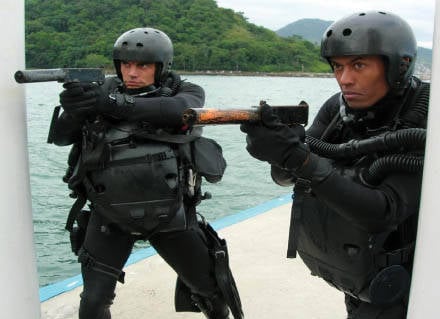 The course is designed for 16 weeks, and it can be held by servicemen in the rank of captain to rank-and-file among volunteers who joined the special operations brigade. The operator of psychological warfare must have basic knowledge in a number of specific areas, such as anthropology, sociology and psychology. It is also necessary to have certain characteristics, such as adaptability, creativity, flexibility, initiative and objectivity.
The course is designed for 16 weeks, and it can be held by servicemen in the rank of captain to rank-and-file among volunteers who joined the special operations brigade. The operator of psychological warfare must have basic knowledge in a number of specific areas, such as anthropology, sociology and psychology. It is also necessary to have certain characteristics, such as adaptability, creativity, flexibility, initiative and objectivity.Special purpose company 3
The Brazilian army pays special attention to the Amazon River, which is 5 million square kilometers, about half of the entire country. Here is the largest watershed, the largest area of wet deciduous forests and the world's largest gene bank. The area represents about two thirds of the Brazilian hydropower potential and includes the 23 thousands of kilometers of navigable rivers. Nedra contain a large amount of mineral resources. However, despite its enormous wealth, the Amazon region is full of contrasts and is a complex mosaic of the many problems that create a difficult situation in the region.
Currently, the Brazilian army considers the Amazon region the most important and most likely region to use. In September, 2003 was reorganized in the structure of the special operations brigade, which resulted in the formation of a special purpose 3 company (3 Cia Esp F), which came under the direct command of the military commander in the Amazon region. The use of special forces in Brazil in remote parts of the country, such as the Amazon region, is not at all uncommon. Over the past 50 years, various special forces have been used repeatedly in various parts of the Amazon jungle. The special purpose 3 company was specially formed for operations in the northern territories. The company was created to provide advisory assistance to the military command of the Amazon in the planning of special operations and the use of special operations forces in this complex area.
In fact, the company is the vanguard of the special operations brigade, which is already deployed in the Amazon region. It is also intended not only to increase the operational capabilities of the military commanders in Amazonia, but also to optimize the use of operational units of the brigade in the region. In accordance with the task at hand, the personnel of the company undergo training to successfully operate in the difficult conditions of the natural environment, and also study the culture of the tribes living in the Amazon region.
The special purpose 3 company is able to deploy its operational units at a distance of up to three thousand kilometers. They are able to operate for a long period of time, being in an aggressive natural environment or areas minimally provided with any infrastructure, logistics and telecommunications. Thus, in the zone of application of the special purpose operational detachments, a company, having supporting elements, is capable of providing adequate material and technical support, communications and control. Its strategic regional mobility is ensured by the use of units of the 4 th battalion of army aviation, the separation of transport aircraft of the Brazilian Air Force or the use of river vessels of the center of military vehicles of the Amazonia military command. They can receive fire support from aviation units located at the air base, which is deployed in the north of this region.
The most important feature of the 3 Company is that it can be used to strengthen other units of the brigade during special operations. Although some of the missions of its units perform independently. The potential and flexibility of a company is very well suited to perform complex operations or actions in collaboration with other government agencies that operate in the north of Brazil.
Special operations support squad
The Special Operations Support Unit (Destacamento de Apoio às Operações Especiais - Dst Ap Op Esp) was created on July 22 on the 2002 of the year and, like the other brigade units, was stationed in Goiânia. He launched 2 on January 2004 of the year.
The detachment is responsible for preparing an advanced group of soldiers for the landing and for providing communication and control during the landing.
The detachment also provides advice on the introduction of guided parachutes, developed in cooperation with the State University of Goiás. To support the activities of special operations brigade units operating for a long time abroad (for example, in Côte d'Ivoire), IN-MARSAT satellite communication stations have been developed and are being used.
Tasks of the special operations support detachment:
- supporting the command of the special operations brigade with material and human resources, as well as ensuring its security;
- installation, operation and maintenance of communication facilities of the brigade of special operations;
- the deployment of a brigade of special operations and ensuring its security;
- provision of limited support to brigade transport units;
- logistical and managerial support of operations for the withdrawal of operational detachments to the area of operations and their evacuation after the completion of the task;
- laying of parachutes and airborne support;
- implementation of logistical support for medical units of the brigade.
1-th platoon of protection against chemical, biological and nuclear weapons
In connection with the existing threats of the potential use of poisonous substances and bacteriological weapons 4 September 2003, the 1 th platoon of protection against chemical, biological and nuclear weapons (1 Pelotão de Defesa Química, Biológica e Nuclear - 1 Pel DQBN) was created. This small unit was part of the special operations brigade, seriously expanding the possibilities of connection and strengthening it.
The task of the platoon is to analyze the risks of using chemical, biological or nuclear weapons. Through such an analysis, experts determine the level of vulnerability of troops in a given operational area. 1-th platoon with the help of special equipment constantly monitors the level of contamination or contamination, and also on the basis of the data obtained performs work on the degassing and decontamination of personnel, weapons and equipment.
The platoon organizationally consists of two main divisions:
- teams supporting the capabilities of protection against chemical, biological and nuclear weapons. Based on special operations, she is responsible for monitoring troop vulnerability, providing means of protection and disinfection;
- the team of combating chemical, biological and nuclear terrorism, which works in conjunction with the special purpose battalion of the 1. It acts as a response force, ready to contain any threat of the use of weapons of mass destruction against troops and the population. In addition, military units supervise the use of non-lethal weapons in a crisis situation.
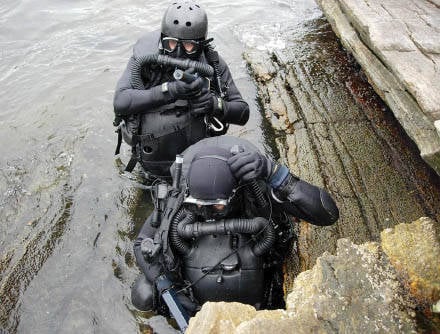 The platoon has experience in solving important tasks in ensuring the safety of visits by VIPs, he has prepared and conducted exercises with UN inspectors responsible for verifying possible nuclear tests in Latin America. The platoon took part in the exercises dedicated to the elimination of the accident at the Angra dos Reis nuclear plant and trained the units of the Brazilian army.
The platoon has experience in solving important tasks in ensuring the safety of visits by VIPs, he has prepared and conducted exercises with UN inspectors responsible for verifying possible nuclear tests in Latin America. The platoon took part in the exercises dedicated to the elimination of the accident at the Angra dos Reis nuclear plant and trained the units of the Brazilian army.6 platoon of the military police
The main task of the platoon is to support the implementation of specific tasks by the special operations brigade, as well as by the army military police. The platoon ensures the safety of special operations during the deployment period, as well as escort and guard units of the brigade.
In addition, the special operations brigade includes a special operations instructor center, which we will discuss in a separate publication.
Information